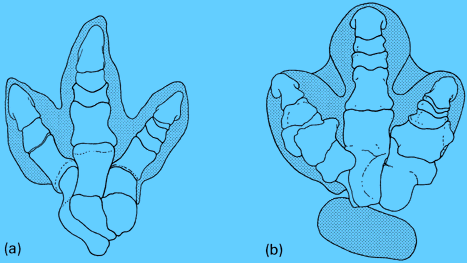


|
|
(a) Foot skeleton of the early Cretaceous ornithopod Iguanodon superimposed on a footprint from rocks of similar age. (b) Foot skeleton of the hadrosaur Hypacrosaurus superimposed on a suspected hadrosaur footprint from the Upper Cretaceous of Alberta, Canada. (Adapted from (a) Dollo, L. (1906) Les allures des iguanodons, d'après les empreintes des pieds et de la queue. Bulliten Biologique de la France et de la Belgique, 40: 1-12, and (b) Langston, W. (1960) A hadrosaurian ichnite. Natural History Papers of the National Museum of Canada, 4: 1-9.) |
|
The most enlightening clue to the identity of the track-maker is the shape of its footprints. But, again, there are numerous technicalities involved in reaching an objective assessment of footprint shape: it is just as difficult to quantify and compare the shapes of footprints as it is to measure their sizes. Some standard procedures for describing footprint shape were introduced in the previous chapter, and they are important because they reduce (though never eliminate) the risk that two palaeontologists will reach different opinions about the shape of a footprint and, hence, about the identity of a track-maker. Despite this element of subjectivity [see Thulborn Reprint "It Can be Difficult to Determine the Boundaries of A Footprint"] it remains true that each group of dinosaurs had its own characteristic pattern of foot structure and tended to leave correspondingly distinctive footprints. Dinosaurs with tridactyl feet tended to produce three-toed footprints, those with slender feet tended to produce narrow footprints, and so on. In other words, it may be assumed that each footprint is a reasonably faithful impression of the foot that made it. The obvious way to discover which sort of dinosaur was responsible for a trackway is simply to match up the footprints with dinosaur feet of the most appropriate shape and size. Such matching up of dinosaur footprints against dinosaur feet has long been standard practice (see diagram). Sometimes the fossil footprint is compared directly to an actual foot skeleton; alternatively, one may work from the evidence of the footprint alone, attempting to visualize the shape of the foot that might have produced it. On occasion, it is useful to follow the reverse procedure, by predicting what sort of footprint would be produced by a particular foot skeleton. This last exercise entails something more than laying out the foot bones on a sheet of paper and tracing round them with a pencil. Instead it is necessary to arrange (or at least envisage) the foot bones in a life-like attitude, with the bases of the digits lifted from the substrate and the metapodium inclined up and backwards. Then, when they are projected on to the horizontal plane, these inclined elements will appear properly foreshortened, as they would be in an actual footprint. |